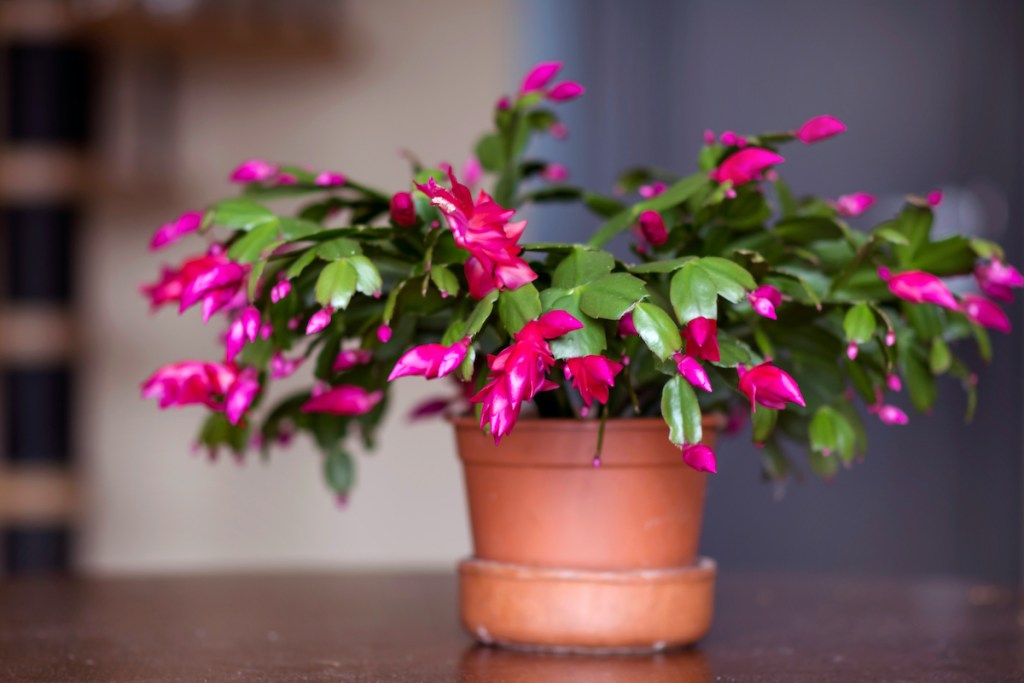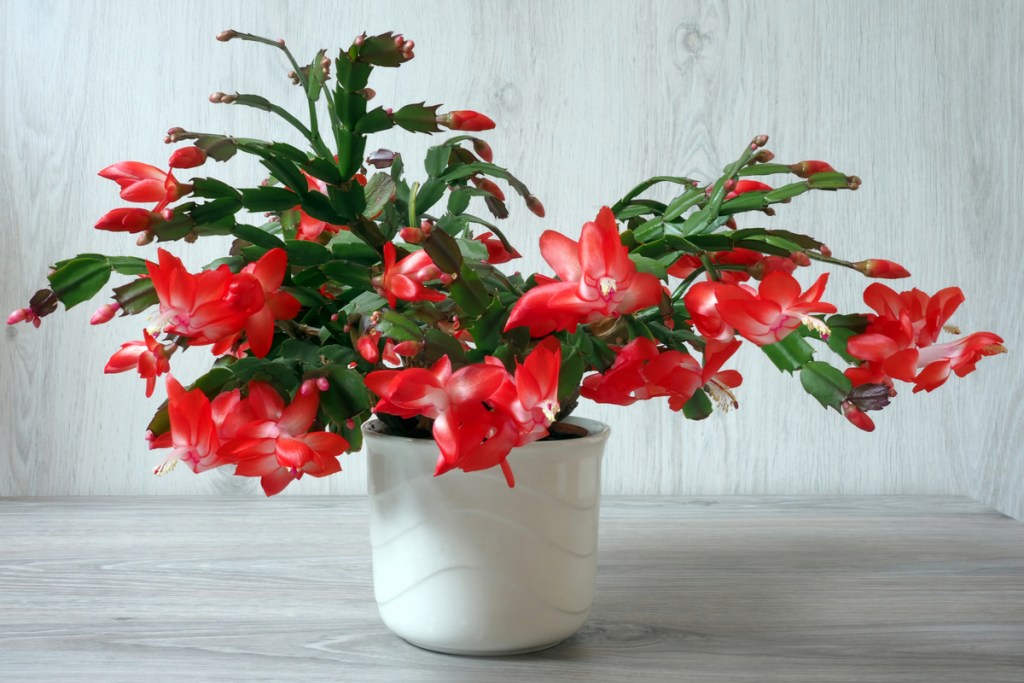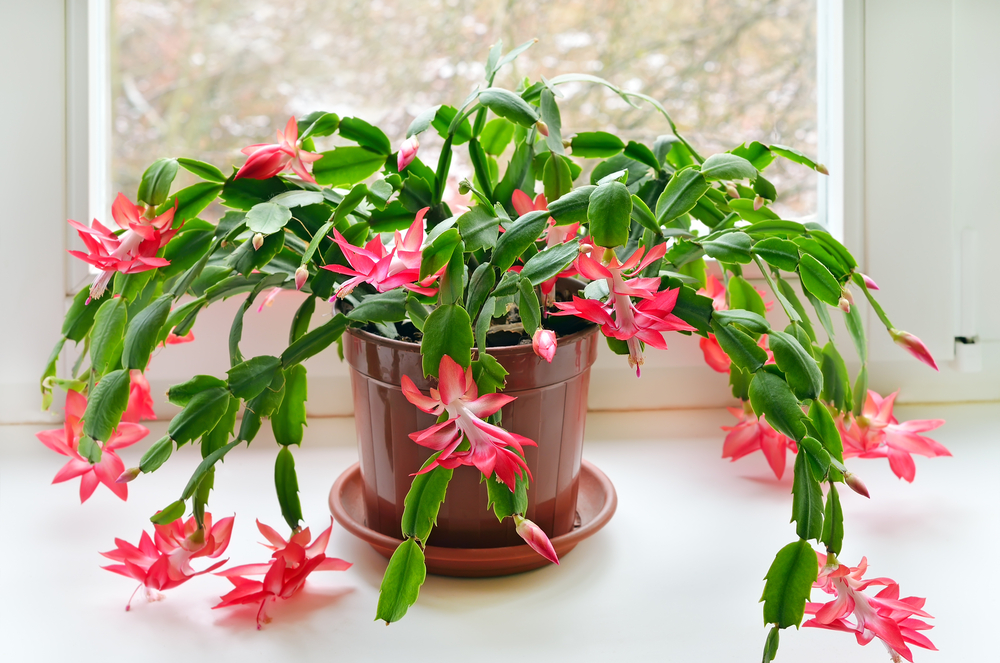The Christmas cactus, often referred to as the "holiday cactus," is a low-maintenance and lovely plant. The beautiful pink and red flowers that appear from Thanksgiving to the new year add festive cheer to any home, making these plants nearly as popular as poinsettias. No matter what holidays you celebrate, these cacti will brighten any dreary winter days that come your way.
Despite sharing a name, did you know that the Christmas cactus is actually different from the holiday cactus? The holiday cactus (Schlumbergera x buckleyi) is in the same family as both Christmas and Thanksgiving cacti, but is a different variety. Neither is more difficult to care for than your average cactus, though. If you’ve already got some of those little guys in your collection, why not pick up a Christmas cactus, too?

Why you should grow one (or tons!) in your home
The Christmas cactus is an easy-to-care-for plant that, when cared for well, will reward you with stunning orange, pink, purple, red, or white blooms during the holiday season. While most other houseplants have entered dormancy and aren’t flowering, you’ll be able to enjoy pops of color from this (non-spiney!) cactus, especially when paired alongside a few poinsettias.
If you can get your hands on some Christmas cacti that have different colored blooms, it may be worth growing more than one! They shine in hanging baskets, and their unique shape still offers beautiful greenery during the seasons when they aren’t blooming.
Is the Christmas cactus different from the Thanksgiving or Easter cactus?
Yes and no! All three are types of holiday cacti; however, they’re different varieties that are often mislabeled for one another (and for the holiday cactus in general). The Christmas cactus (Schlumbergera russelliana) is a variety bred from the holiday cactus (Schlumbergera x buckleyi) and the Thanksgiving cactus (Schlumbergera truncate). The two together result in the beautiful blooms and specific blooming time that the Christmas cactus has.
Let’s take a look at the other two:
- The Thanksgiving cactus (Schlumbergera truncate). The Thanksgiving cactus starts blooming in late fall within a few weeks of Thanksgiving. Its flat stems have jagged edges, appearing somewhat like little claws.
- The Easter cactus (Rhipsalidopsis gaetneri). The Easter cactus blooms in early spring, usually around March, and continues to bloom through May. You may even start seeing buds as early as February!
Although they’re all similar in appearance, they don’t bloom at the same time. If you want to create a dynamic feel for your space, try having one or two of each hanging in your home! That way, you’ll be able to enjoy blooms for an even longer period of time during the typical inactive season.

How to care for a Christmas cactus
Caring for a Christmas cactus isn’t complicated, especially if you’re already used to the nuances of other cacti varieties. However, there are still some differences. Here's how to care for your Christmas cactus.
Step 1: Keep your Christmas cactus in a high humidity environment.
The critical difference is that the Christmas cactus is native to tropical environments instead of dry, arid ones. They need much higher humidity levels (more so during their blooming season, due to the dry conditions of winter)
Step 2: Place the Christmas cactus where it will be warm during the day and slightly cooler at night, especially when it begins to bloom.
The Christmas cactus prefers environments around 70 to 80 degrees Fahrenheit during the active growing season; however, once the buds start to set, it prefers a space that drops to 55 to 65 degrees Fahrenheit at night.
Step 3: Keep your Christmas cactus away from drafts.
Step 4: Place your cactus in partial or diffused light.
Step 5: Avoid placing it in direct light or full sun during spring, summer, and fall.
Step 6: Water it thoroughly and allow the soil to dry out completely before watering again.
Step 7: Prune your cactus after it has bloomed.
Like other houseplants, you can prune a Christmas cactus to help encourage branching and fuller growth! The best time to do so is right after it’s done blooming, though pruning can be done safely until late spring without posing much risk to the plant.
Step 8: Deadhead spent blooms.
Step 9: Use a sterilized pair of shears or scissors to remove branches when pruning.
Step 10: Avoid taking more than a third of the plant.
Up to a third of the cactus can be removed without stressing the plant; however, if you want to be on the safe side, start with one or two segments of a few stems and see how it does.

Can a Christmas cactus be propagated?
Yes, and you can even use the trimmings as cuttings for new Christmas cacti! The best time to propagate lines up with the best time to prune (convenient, huh?), so you won’t have to worry about leaving some stems on the plant for propagation later on. To successfully propagate a new Christmas cactus from cuttings:
Step 1: Prep a container filled with cactus-specific potting mix.
Step 2: Take a cutting or cuttings from your cactus with a sharp clean pair of scissors or knife.
Step 3: Store the cuttings somewhere dry for two to four days until the ends have calloused.
You can skip this step if you don't have the space or time to let them dry, however leaving them to callous typically yields better results.
Step 4: Place the cut end of the cutting directly into the potting soil.
Step 5: Water lightly, letting the soil dry thoroughly between waterings.
Roots on viable cuttings should start to form within two to three weeks.

The best way to encourage blooms on your Christmas cactus
If you’re wondering what you can do to help ensure you get some beautiful blooms around the holiday season, the answer is simple: proper care. By caring for your Christmas cactus the way it prefers, you’re setting it up to have the energy, nutrients, and growth it needs to bloom.
Keep in mind that the more stems you have, the more places your cactus has to bloom! Pruning yearly benefits the plant in more ways than one, and it can even give you more cacti to hang around your home.
Editors' Recommendations
- Everything you need to know about trailing succulents care for lush, thick growth
- How to pick the perfect orchid pots for healthy blooms
- Beyond basil and cilantro, add these unique plants to your indoor herb garden
- Beautiful, low-maintenance pothos varieties to add to your plant collection
- 5 easy-care spider plant varieties perfect for any home garden



